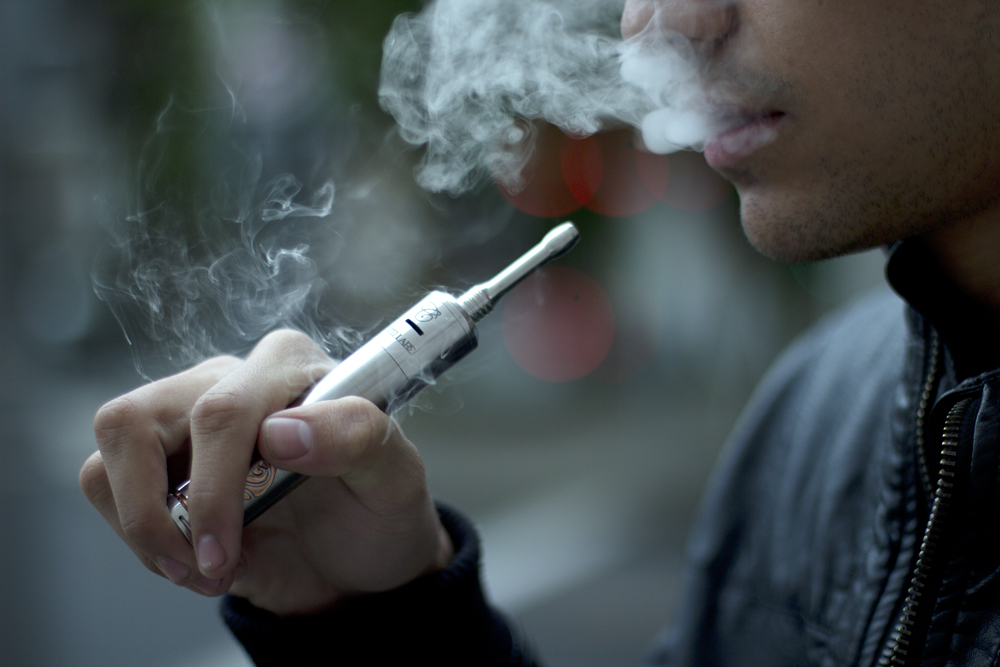The health effects of electronic cigarettes, known popularly as e-cigarettes, are still widely unknown. The burgeoning e-cigarette industry currently touts their product as safer than traditional tobacco smoke products, and many smokers are buying in. A team of PSU scientists is investigating just what happens on the chemical level when the vaporizer lights.
“A common misconception is that it’s just water vapor that you’re seeing [when people smoke e-cigarettes],” said Dr. James Pankow, professor of chemistry and environmental engineering, and part of the team studying the e-cigarettes’ chemical reactions. “In fact it’s almost zero water.”
Pankow and collaborator Dr. David Peyton said that the signature vapor emitted by e-cigarettes is primarily composed of propylene glycol and glycerol. According to the Flavor Extract Manufacturers’ Association, a lobbying group for the flavor manufacturing industry, these compounds are relatively harmless to consume—in food items. This is a distinction worth noting, according to Pankow and Peyton.
“Thousands of compounds have been cleared by this organization as being generally recognized as safe to eat,” Pankow said.
Pankow pointed out what he called an explicit disclaimer on FEMA’s website about whether FEMA regards flavors as safe to inhale.
FEMA notes in a specifically designated section of its website that it “does not evaluate flavor ingredients for use in tobacco products including e-cigarettes or other products that are not human food, or products that result in exposures other than by ingestion.”
Peyton agreed with Pankow. He also pointed out that the high temperatures to which the element heated e-cigarette additives—over 600 degrees celsius—resulted in the creation of molecules not previously seen.
In an email, Peyton discussed these molecules.
“We don’t know all of what goes on when they’re inhaled, or when you heat them up in the presence of oxygen. There’s certainly some interesting chemistry that goes on,” he stated. “Reactions do occur, and because we’re talking about bulk solvent, just a few percent of the molecules reacting generates a fair amount of molecules which can then have significant, and so far unknown effects.”
Compared to regular cigarettes, these electronic counterparts are relatively simple; fewer components go into an e-cigarette, from liquid manufacture to smoker. Whereas the leaf material of a common tobacco product can involve thousands of compounds, the e-cigarette is simplified, involving controlled extractions, a heating element and some additives for flavoring.
Pankow expressed concerns over this simplicity leading to greater problems in the long term.
“The parent compounds could be converted to something else, something that could be toxic,” Pankow said.
He added that it is too early to tell whether the new molecular combinations pose any threat.
Both Peyton and Pankow acknowledged the demonstrated dangers of traditional cigarettes. But they also pointed out that cigarettes have had a longer lifespan to show their true colors.
“If you make a comparison with e-cigarettes, people have only been smoking for a relatively short period of time,” Pankow said. “It takes time for them to take their toll. It would be a false sense of security.”






“the high temperatures to which the element heated e-cigarette additives—over 600 degrees Celsius”
Sorry, that’s just rubbish. A more realistic figure is 200°C in a high-powered device. Pankow and Peyton presumably measured the coil temperature as part of their research, so either they had improperly modified the device or they are being less than entirely honest.
I feel sorry ffor anyone tryin to vape @ 600 degrees Celsius :/
At 600 degrees celcius, the wick would have caught fire, and the juice as well probably. And the insulators would have melted as would the tank if it was plastic. So some more superb research and science from Peyton.
My vape is made of aluminum. The MELTING POINT of aluminum is 620 degrees Celsius. That should tell you all you need to know about how realistic this ‘science’ is.
““It takes time for them to take their toll.”
Sounds like he’s already reached a conclusion that there’s going to BE a toll, despite admitting that there’s no evidence.
“over 600 degrees celsius” ? I think you need to consult someone who knows what they are doing. At that temperature, not only would it be un-vapeable but positively dangerous due to the formation of aldehydes.
My temperature controlled devices are set for a maximum of 200°C, but the measured coil temperature rarely exceeds 185°C.
At 600°C it would be dangerous enough without aldehydes. The vapour temperature would burn your lips off.
more ass hattery for the clueless..
I started vapping in 08 thanks to the swag bag given at the 2008 Grammy’s and i know for a fact my lungs are pink again and my fingers are no longer yellowy brown..to think any of these tests are not funded in some way by big tobacco is pure nonsense..